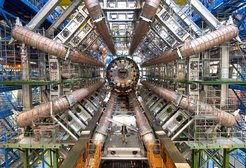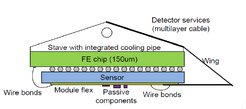ATLAS
The major projects during the nineties were the development of detectors being able to withstand harsh radiation environments at the Large Hadron Collider (LHC) at CERN in Geneva. At LHC protons are brought to collision with a center of mass energy of 14 TeV. At this high energies new particles might be produced which was finally putting some light on one of the remaining mysteries of particle physics: The origin of mass. The ATLAS detector is one of the two large detectors at LHC which detects such particles. With further planned upgrades detector developments are getting even harder requirements and are being pushed further to their limits.
The MPG HLL was deeply involved in the ATLAS project namely in the development of the inner detector with its silicon tracker (SCT), based on silicon strip detectors and the vertex detector, based on hybrid pixel detectors.

The results of the detector development at MPG HLL had an essential impact on the detector decisions made for ATLAS SCT and ATLAS Pixel. Using detectors designed and fabricated in our laboratory demonstrated that the required properties can indeed be fulfilled. After this demonstration both ATLAS sub-detectors opted for the concepts we proposed. The novel ATLAS pixel sensors use an n-in-n technology (n+-doped readout pads in n-doped substrate) and were fabricated with a new p-spray isolation technology developed and patented by MPG HLL.
MPG HLL was a pioneer in the development of the existing Pixel detectors for ATLAS and CMS, introducing two novel features, i.e. the rad-hard p-spray pixel isolation technique and the punch through pixel biasing scheme (PT-bias structure) which allows sensor testing before module mounting. Both features were adopted by all presently existing hybrid pixel sensor producers
Current activities

A high luminosity upgrade is planned for the Large Hadron Collider at CERN. The planned luminosity increase of almost an order of magnitude up to more than 5*1034cm-2s-1 sets much higher requirements to all sub detectors in terms of finer segmentation, faster readout, more storage capability and much more radiation damage. The ATLAS detector has to be prepared for this high luminosity upgrade. The whole inner tracker (ITK) containing the Pixel and the Strip detector has to be reconstructed to accomplish these challenges. The proven Hybrid Pixel concept with read out electronics chips, flip chipped to sensors and connected via bump bonds, will stay but the read out chip as well as the pixel sensors will be completely re-engineered. P-spray isolation and PT-bias will be also used in the upgraded sensors. They were subject of numerous parameter variations within three prototype productions. The design optimization and verification is carried out together with the ATLAS Pixel Group at Max-Planck-Institut für Physik (MPP). To cope with the high luminosity and the related occupancy, eight times smaller pixels either 25x100μm² or 50x50μm² will be used – instead of currently used 50x400μm². Since the PT-bias structure cannot be scaled with the pixel size inevitable charge losses caused by this structures compromise the detection efficiency more severe than before. HLL has proposed a new scheme called split design. Test beam results show that the split design improves the efficiency from 98.5% to 99.9% for non irradiated sensors and from 96.5% to 97.2% for heavily irradiated ones.

